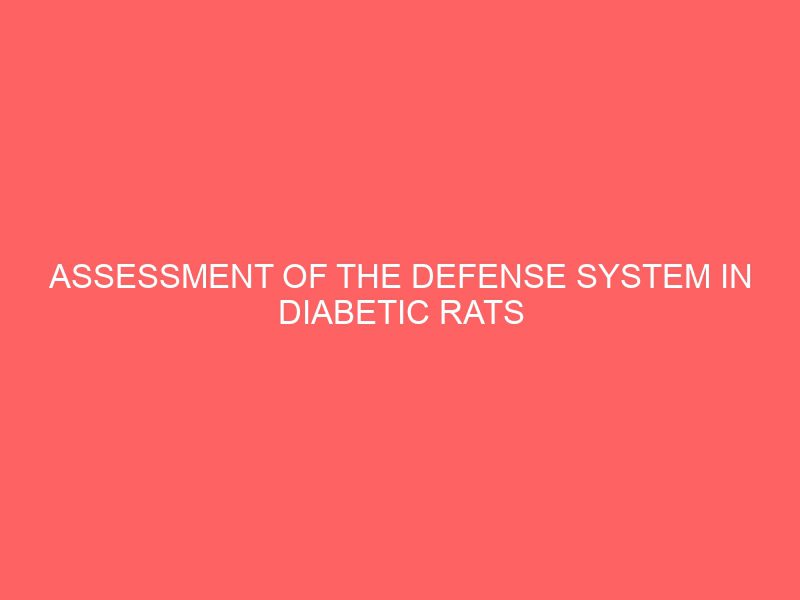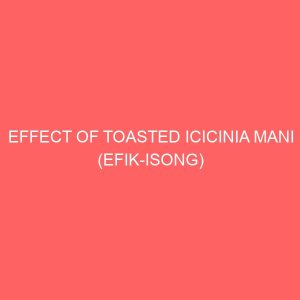Description
CHAPTER ONE
1.0 INTRODUCTION
The prevalence nature of micro-organisms caused the human body to develop a natural defense system against the adverse effects of these organisms (Pick et al, 2008). A complex network of specialized cells, glands, organs, specialized proteins and molecular messengers make up the body defense system which is typically known as the “IMMUNE SYSTEM”, and this immune system prevents bacteria, fungi, viruses, parasites and any other external antibodies from over multiplying inside the body and inflicting harm to the body system and processes (Godfrey et al, 2006).
The immune system which is the body’s natural defense system against invading pathogens protects the body from infection and works to communicate an individual well being through a complex network of interconnected cells and cytokines (Tang et al, 2009). This system has the power to initiate a wide range of cellular responses with the ability to directly attack an invading organism or signal cells to begin the healing processes (Gartner and Hiatt, 2007).
Although this system is an associated host defense, an uncontrolled immune system has the potential to trigger negative complications in the host (Walter 2007; Kushner, 2003). Therefore, well controlled regulation of the immune system is necessary in order to prevent autoimmune responses from occurring (Morran et al, 2008).
In order to protect the body against foreign pathogens, the immune system has developed throughout evolution to recognize the difference between the ‘Self and non-self’ cells. The ability to become self – tolerant toward the body’s own proteins and antigens is critical to maintaining a properly functioning immune system (Bruce et al, 2010). An immune system that loses tolerance to the “Self” cells loses ability to differentiate between “friends” and “foes” in immunological battles (Kushner, 2003; Walter, 2007). This loss of tolerance leads the immune system towards autoimmune responses, in which the body attacks itself, thereby causing substantial damage to the self, even inflicting irreversible damage (Litman et al, 2005).
The immune system is composed of two unique components or branches, each with its own responsibilities. The innate immune system is the body’s first-line of defense against invading pathogens. This system recognizes common structural components of pathogens and elicits immune response to signal the presence of pathogens and infections (Mayer, 2006). The adaptive immune system is the body’s second-line of defense and especially targets identified pathogens. This system is antigen – specific and generates immunological memory within the host, which allows for more efficient pathogen clearance upon repeat exposure to the same pathogens (Agerbeth and Gudmundson, 2011). Although, these two immune systems are termed different branches of the immune system, they must work together as one unified system to protect the body (Ogawa and Calhoun, 2010).
The immune system protects the host, but it also posses the ability to harm the host as well. Numerous autoimmune diseases have been characterized overtime (Godfrey et al, 2006; Pick up et al, 2008; Morran et al, 2008). The result of the autoimmune system leads to alternations in the functioning of the immune system, due to genetics, cellular malfunctions or cell signaling functions and this in turn, leads to the development and pathogenesis of autoimmune diseases like diabetes mellitus (Von and Oldstone, 1997).
Diabetes mellitus is a disease characterized by the body’s inability to accurately maintain normal blood glucose levels, leading to multiple detrimental effects (Shoback et al, 2011). Insulin is an important hormone in glucose metabolism. When insulin is released, it signals cells to take up glucose. If the body is unable to produce insulin, blood glucose level remains elevated and this is termed hyperglycemia (Rother 2007).
Diabetes mellitus is an autoimmune disease, in which the immune system targets and destroys the insulin – producing beta cells found in the Islets of Langerhans in the pancreas (Delovitch and Singh, 2012). Without insulin, individuals develop the clinical syndrome of diabetes mellitus. Diabetes mellitus is characterized by auto-antibody production and progressive infiltration of immune cells into the Islets of Langerhans in the pancreas, followed by the destruction of the Islets cells (Bardsley and Want, 2004). Studies using human and murine models of diabetes have demonstrated that, the autoimmune destructive process in diabetes mellitus occurs in a cell – mediated organ – specific manner (Nepom, 1995; Yoon and Jun, 2001).
Diabetes mellitus is a chronic disease, for which there is no known cure except in very specific situations (Janeway, 2007). Medically, the management of diabetes mellitus concentrates on keeping the blood sugar levels as close to normal (euglycemia) as possible, without causing hypoglycemia (Delovitch and Singh, 2012). This can usually be accomplished with diet, exercise and the use of appropriate medications (insulin). Diabetes mellitus is typically managed with a combination of regular neutral Protamine Hagedorn (NPH) insulin or Synthetic insulin analogs (Ripson et al, 2009).
Despite the medical development to curb the increased cases of diabetes, it in still prevalence in the society, hence, this project work “Assessment of the defense system in diabetic rats treated with aqueous leaves extract of Terminalia catappa”, to find out if there is a curative agent in the leave of Terminalia catappa based on the recent report of Ahmed et al,( 2005) on the leaves.
The universal role of plants in the treatment of disease is exemplified by their employment in all major systems of medicine irrespective of the underlying philosophical premise (Cunningham et al, 2005). There is a great wealth of knowledge concerning the medicinal, narcotic and other properties of plants that is transmitted orally from generation to generation by tribal societies, particularly those of Tropical Africa, Asia, North and South America and the pacific countries (Duke, 2002).
Ahmed et al (2005) reported that, the leaves of Terminalia catappa contain several flavonoids, tannins, saponins, triterpiniod and phytosterols. Due to the above chemical richness, the leaves are used in different traditional medicines for various purposes worldwide. They also reported the biochemical effects of administering Terminalia catappa Linn aqueous and cold leaf extracts, orally and showed that it caused the regeneration of the Beta cells of the Islets of Langerhans, decreased blood sugar, serum cholesterol, triglycerides, low density lipoprotein (LDL), creatinine, urea and alkaline phosphatase levels, while increasing the high density lipoprotein (HDL) level in diabetes mellitus (Nyarko and Addy, 1997). However, not much is reported about the various blood cells involve in the body defense system.
AIM OF THE STUDY
Considering the development of diabetes mellitus to be immune system related, it become of interest to find out what could be the possible state of the body defense system comparatively in diabetic and non-diabetic conditions.
SCOPE OF THE STUDY
The study will cover the aspect of differential white blood cell count and serum globulin levels as a preliminary investigation on the body defense system.







